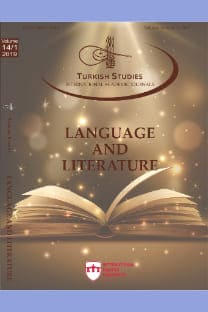AHAB GÜNEŞ’E, HOUSE TANRI’YA KARŞI: AĞRISIZ HAYAT
AHAB VS. SUN; HOUSE VS. GOD: LIFE WITHOUT PAIN
___
- Amaro, L. M. (2012). Diagnosing Dr. House: Codependency, agency, and third wave contradiction. Western Journal of Communication, 76:5, 520-535, DOI: 10.1080/10570314.2012.679983
- Barnett, B. (2010). Chasing zebras: The unofficial guide to House, M. D. Toronto: ECW Press. Retrieved from http://www.ebrary.com
- Blake, P. (Writer), & Straiton, D. (Director). (2009). The Tyrant [Television series episode]. In T. L. Moran, R. Friend, G. Lerner, B. Singer, D. Shore, P. Attanasio, & Katie Jacobs (Executive Producers), House M.D. Los Angeles, CA: Fox Broadcasting.
- Cone, R. E. (2008). A new treatment for phantom limb pain?: A tri-partite mirror apparatus and cognitive behavioral therapy (Doctoral dissertation). (Order No. 3326852). Available from ProQuest Dissertations & Theses Global. (304821486). Retrieved from http://search.proquest.com/docview/304821486?accountid=8403
- Dick, L. (Writer), & Sackheim, D. (Director). (2007). The Jerk [Television series episode]. In D. Sackheim, B. Singer, D. Shore, P. Attanasio, & K. Jacobs (Executive Producers), House M.D. Los Angeles, CA: Fox Broadcasting.
- DuBose, M. S. (2010). Morality, complexity, experts, and systems of authority in House, M. D., or “my big brain is my superpower”. Television & New Media, 11(1), 20-36. doi: 10.1177/1527476409343800
- Dyer, S. K. (1994). Narcissism in the novels of Herman Melville. Psychiatric Quarterly, 65(1), 15-30. doi:10.1007/BF02354329
- Egan, D. (Writer), & Showalter, J. F. (Director). (2006). House vs. God [Television series episode]. In B. Singer, D. Shore, P. Attanasio, & K. Jacobs (Executive Producers), House M.D. Los Angeles, CA: Fox Broadcasting.
- Foster, D. (Writer), & Gerber, F. (Director). (2006). All in [Television series episode]. In B. Singer, D. Shore, P. Attanasio, & K. Jacobs (Executive Producers), House M.D. Los Angeles, CA: Fox Broadcasting.
- Friedman, L. (Writer), & To, T. (Director). (2006). Merry little christmas [Television series episode]. In D. Sackheim, B. Singer, D. Shore, P. Attanasio, & K. Jacobs (Executive Producers), House M.D. Los Angeles, CA: Fox Broadcasting.
- Gilmer, J. (2007). Does god limp? In Wilson, L. (Ed.). House unauthorized: vasculitis, clinic duty, and bad bedside manner. (pp. 140-147). Dallas, TX, USA: BenBella Books. Retrieved from http://www.ebrary.com
- Hanley, M. A., Ehde, D. M., & Smith, D.G. (2006). Pain management. In Carroll, K., & Edelstein, J. E. (Eds.). Prosthetics and patient management: A comprehensive clinical approach (pp.33-52). USA: SLACK Incorporated.
- Herman, J. (1998). Phantom limb: From medical knowledge to folk wisdom and back. Annals of Internal Medicine, 128(1): 76-78.
- Kaplow, L., Shore, D. (Teleplay by), Friend, R., Lerner, G., Kaplow, L., Shore, D. (Story by), & Sarafian, D. (Director). (2006). Meaning [Television series episode]. In D. Sackheim, B. Singer, D. Shore , P. Attanasio, & K. Jacobs (Executive Producers), House M.D. Los Angeles, CA: Fox Broadcasting.
- Kelley, J. C. (Writer), & Gates, T. (Director). (2011). Fall from grace [Television series episode]. In P. Attanasio, R. Friend, H. Laurie, G. Lerner, T. L. Moran, D. Shore, B. Singer, G. Yaitanes, & K. Jacobs (Executive Producers), House M.D. Los Angeles, CA: Fox Broadcasting.
- Lepre. O. (2014). Playing with humor: the translation of humor in video games. In De Rosa, G. L., Bianchi, F., De Laurentiis, A., & Perego, E. (eds.). Translating humour in audiovisual texts (pp. 499-516). Bern, CHE: Peter Lang AG. Retrieved from http://www.ebrary.com
- McVeigh, S. A. (2000). Phantom menace: The mystery of phantom limb pain: A case report and review of the literature. University of Toronto Medical Journal. doi:10.5015/utmj.v78i1.957
- Melville, H. (1966). Moby Dick. Belgrade: Mladinska Knjiga Press.
- Moran, T. L. & Kaplow, L. (Writers), & Jacobs, K. (Director). (2007). Human error [Television series episode]. In D. Sackheim, B. Singer, D. Shore, P. Attanasio, & K. Jacobs (Executive Producers), House M.D. Los Angeles, CA: Fox Broadcasting.
- Rich, L. E., Simmons, J., Adams, D., Thorp, S., & Mink, M. (2008). The afterbirth of the clinic: A foucauldian perspective on “House M.D.” and American medicine in the 21st century. Perspectives in Biology and Medicine, 51(2), 220-37. Retrieved from http://search.proquest.com/docview/233167287?accountid=8403
- Shore, D. (Writer), & Singer, B. (Director). (2004). Pilot [Television series episode]. In B. Singer, D. Shore, P. Attanasio, & K. Jacobs (Executive Producers), House M.D. Los Angeles, CA: Fox Broadcasting.
- Thomson, R. G. (1997). Extraordinary bodies: Figuring physical disability in American culture and literature. New York: Columbia University Press.
- Winters. J. (2007). Dysfunctional family in residence - disturbing group dynamics in House M.D. In Wilson, L. (Ed.). House unauthorized: Vasculitis, clinic duty, and bad bedside manner. (pp. 34- 41). Dallas, TX, USA: BenBella Books. Retrieved from http://www.ebrary.com
- Wolff, A., Vanduynhoven, E., van Kleef, M., Huygen, F., Pope, J. E., & Mekhail, N. (2011). 21. Phantom pain. Pain Practice, 11(4), 403-413. doi:10.1111/j.1533-2500.2011.00454.x
- ISSN: 2667-5641
- Yayın Aralığı: 4
- Başlangıç: 2006
- Yayıncı: ASOS Eğitim Bilişim Danışmanlık Otomasyon Yayıncılık Reklam Sanayi ve Ticaret LTD ŞTİ
ATTİLÂ İLHAN’IN ŞİİRLERİNDE MÜŞTEREK ARAPÇA KELİMELER
SÜLEYMÂN-NÂME’DE MİTOLOJİK BİR UNSUR OLARAK DÎVLER
ESKİ BAŞKENTTE CİNAYET: AHMET ÜMİT’İN İSTANBUL HATIRASI’NDA TARİHSEL İSTANBUL
1967-1970 YILLARINDAKİ DİLDE SADELEŞME VE AKADEMİ TARTIŞMALARININ TÜRK KÜLTÜRÜ DERGİSİNE YANSIMALARI
DOĞU TRAKYA AĞIZLARININ GELECEĞİ
ÇAĞATAY TÜRKÇESİNDEN ÖZBEK TÜRKÇESİNE ANLAM KÖTÜLEŞMESİ ÖRNEKLERİ
BENLİK HAZİNESİNİN KEŞFİNDE İSKENDER’İN İÇSEL YOLCULUĞU
